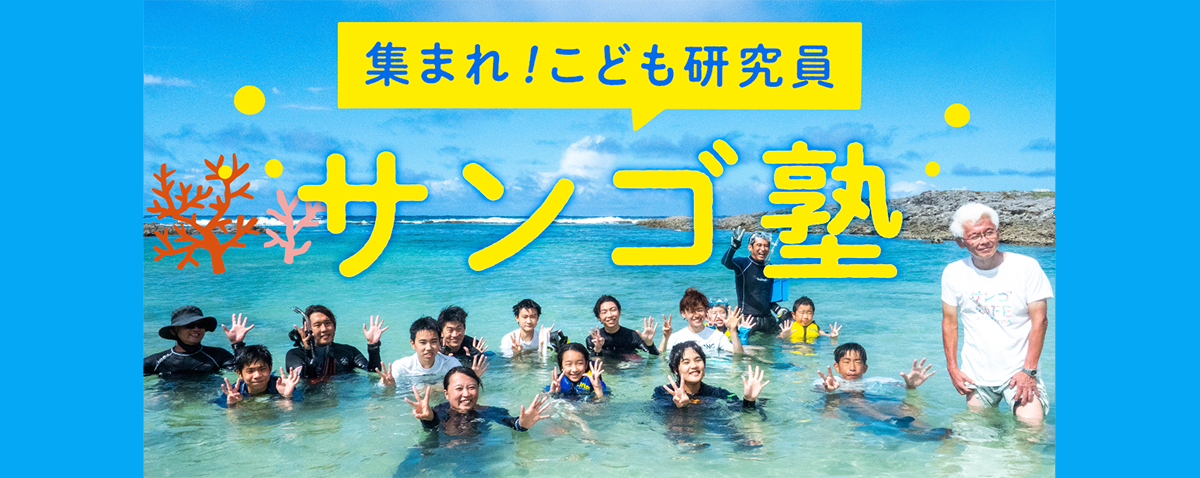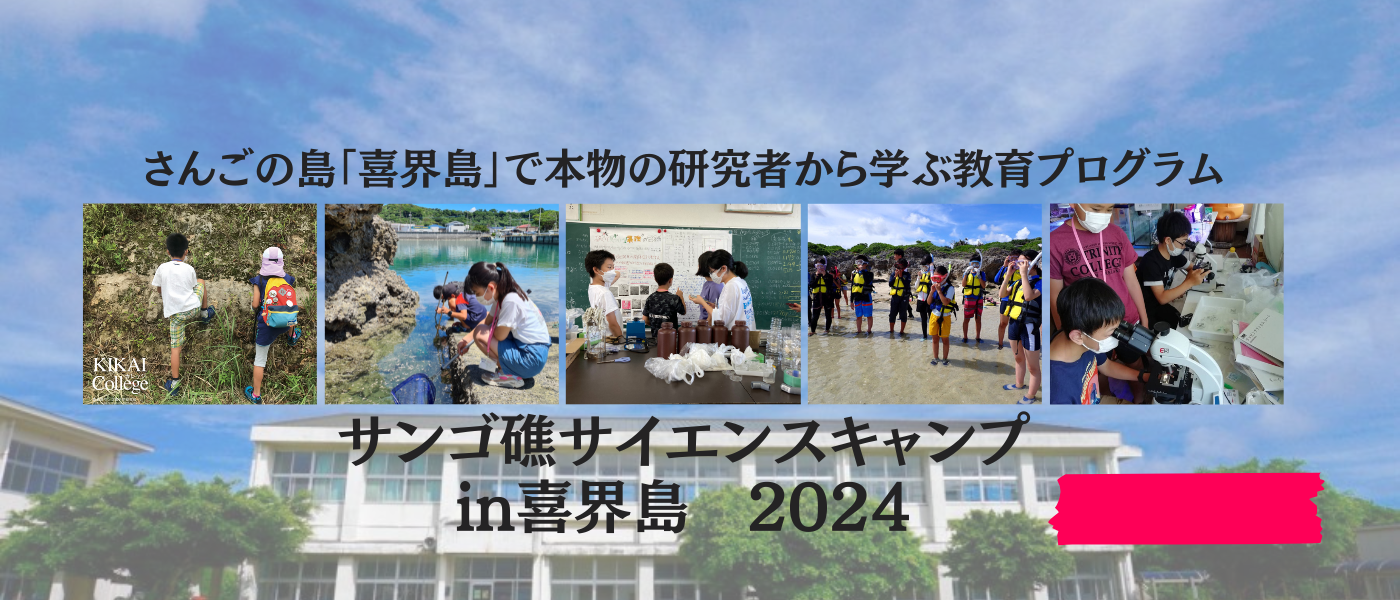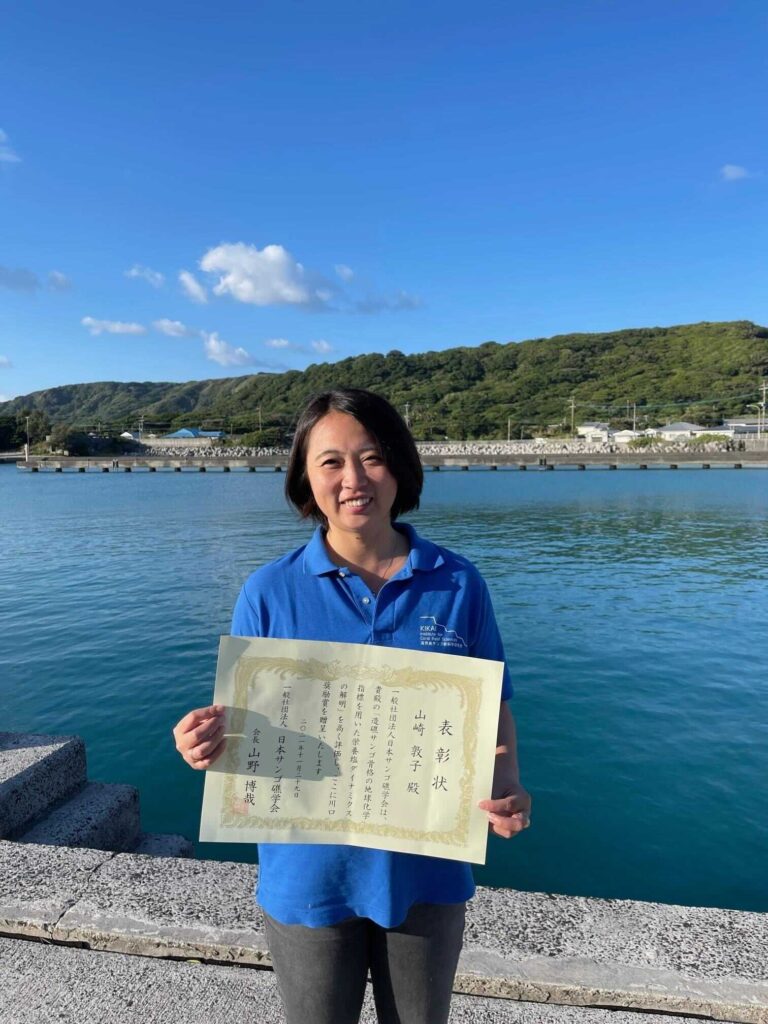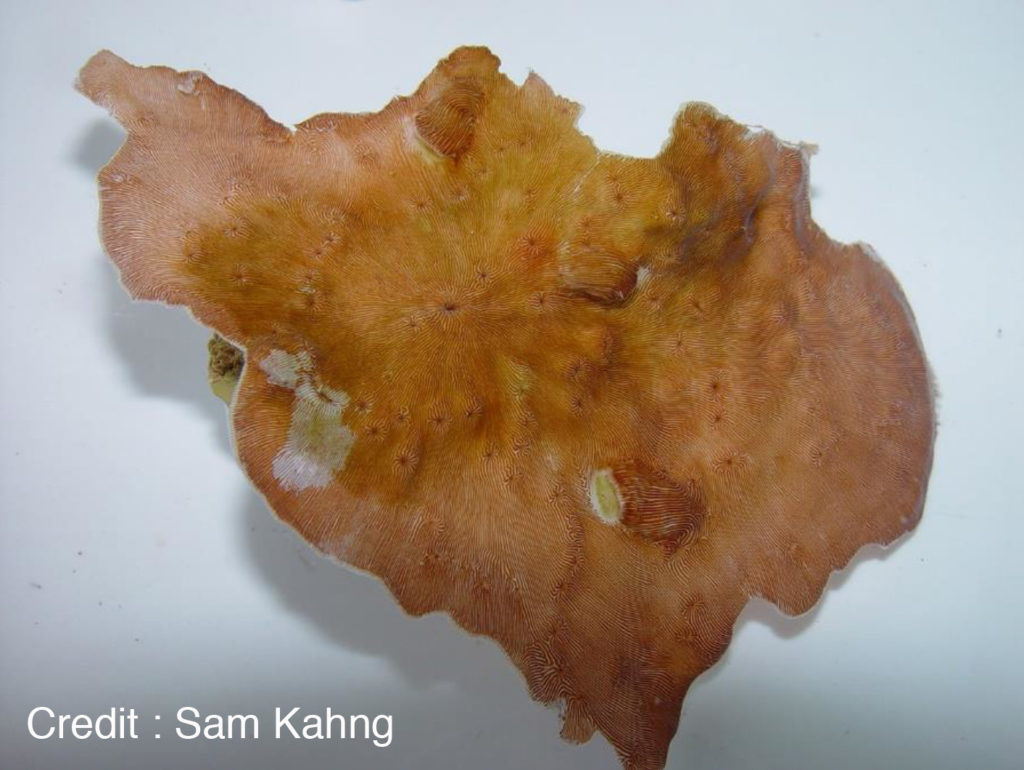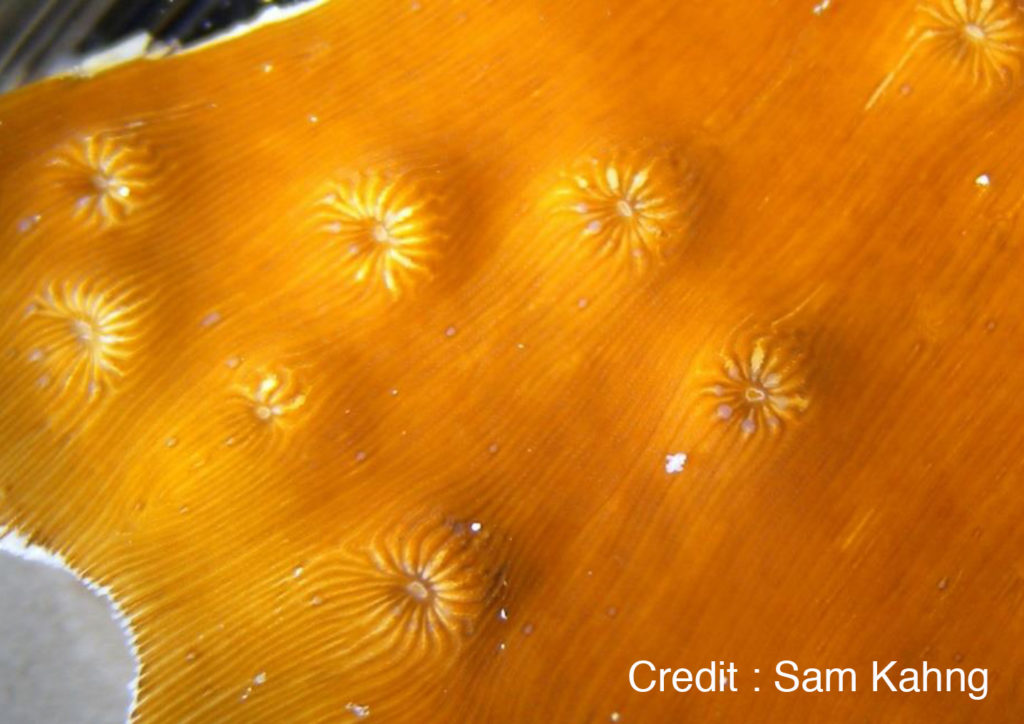プレスリリース
サンゴ礁科学の聖地喜界島でグローバルリーダーを育成する 実践型教育プログラム KIKAI college(キカイカレッジ)開講
2021年11月29日から、サンゴ礁科学を柱に学術分野、地域、社会において人と地球環境からより良い未来を創造する人材を育てる教育プログラムの第一期生の募集を開始。

喜界島サンゴ礁科学研究所(鹿児島県喜界町 理事長:渡邊剛)は、2021年11月29日から、「100年後に残す」をミッションとして、サンゴ礁科学を柱に、学術分野、地域、社会において人と地球環境のあり方を考え、より良い未来を想像する人材を育成する実践型の教育プログラムを提供する、「KIKAI college(キカイカレッジ)」の募集を開始しました。
喜界島サンゴ礁科学研究所は、国際的にも稀少な隆起サンゴ礁から成り立つ喜界島を拠点とし、海洋・地質、およびそれに関わる調査研究を行い、自然科学の発展を普及を目的に活動をしています。このたび設立したKIKAI collegeでは、本科、専科、特科の3つのコースがあり、サンゴ礁研究の聖地と呼ばれるフィールド喜界島を拠点にフィールドワークを行うほか、地球環境科学、サイエンスコミュニケーション、地方創生、アート・デザインなどのプログラムを、各コースごとのカリキュラムで提供をしています(講義は全てオンライン受講可)。
人と地球環境のあり方をサンゴ礁から学び、実践することにより、多様性の高いチームを形成し、マネジメントできる能力を持つ次世代のグローバルリーダーの輩出を目指しています。
喜界島サンゴ礁科学研究所所長の山崎敦子は、開講にあたり以下のようにコメントをしています。
「私たちサンゴ礁研究者は、世界でも稀に見る化石サンゴ礁でできた喜界島に研究所を設立し、美しいサンゴの海とそこで生まれた自然や文化、そして社会を見つめて来ました。この美しい自然と人々の暮らしを残していきたい、そして私たちの研究も将来へとつながっていくように「100年後に残す」という目標を立てました。この小さな島、喜界島は地球のモデルです。この島で起きている問題は、世界のどこでも起きているでしょう。私たちは、KIKAI collegeで学んだことをみなさんが世界中の地域で取り組んだら、地球の未来を変えられると思っています。みなさんが100年後に残したい未来を一緒に考えていきましょう。」
KIKAI Collegeでは、地球環境やサンゴ礁、そして私たち人類について研究をしたい方、地域課題解決や地域活性化に取り組みたい方、環境保全や教育に取り組むための実績を積みたい方に対し、喜界島をはじめとする奄美群島や世界中のサンゴ礁地域を対象に活動の機会を提供しています。
KIKAI collegeの各コースの修了後は、喜界島サンゴ礁科学研究所をはじめとして、それぞれの分野や、世界中の地域で、KIKAI Collegeで学んだことを活かしながら活躍することが期待されます。
現在、KIKAI collegeでは第1期受講生を募集しています。受講を検討している方への体験レッスンや、奨学金などの制度もご用意しています。ぜひ、KIKAI college特設サイトから詳細をご覧ください。
ウェブサイト https://college.kikaireefs.org/
KIKAI college募集要項
■対象:
大学生・大学院生・社会人
■募集定員:本科10名、専科5名、特科5名
■受講方法:
講義は喜界島サンゴ礁科学研究所、またはオンラインで受講できます。
ただし、実習は喜界島サンゴ礁科学研究所で行うため、オンラインでは受講できません。
喜界島サンゴ礁科学研究所で受講される方は、実習やフィールドワーク以外でも研究所の設備を使用することができます。
※オンラインで受講される際、インターネットに接続可能なパソコン、タブレットが必要です。
■応募期間:
受講生の募集は4半期ごとに、下記のとおり行ないます。
2022年1月入学 2021 年 11月 29日 (月)~ 12月 10日(金)<正午締切>
2022年4月入学 2022 年 2月 28日 (月)~ 3月 11日(金)<正午締切>
2022年7月入学 2022 年 5月 30日 (月)~ 6月 10日(金)<正午締切>
■プログラムスケジュール
KIKAIカレッジは感じる・見つける・伝える・残す の4つのプログラムからなり、この4つのプログラムを総合的に習得することを目指します。各プログラムに分類される科目以上には1つのプロジェクトが属しており、プロジェクトは喜界島サンゴ礁科学研究所の事業と結びついています。受講生はプロジェクトの実践を積み重ねることにより、プロジェクトの立案から実施までの過程を習得します。
島の自然、サンゴ礁文化、人の営みを未来へ 喜界島PR動画「喜界島-過去と未来をつなぐ島」公開中
喜界島の魅力を日本全国・世界の人たちへ届けたいという思いを込めて、科学者と写真家の目・心を通して見えてくる喜界島の姿が詰まった動画が完成しました。
喜界島サンゴ礁科学研究所(鹿児島県喜界町 理事長:渡邊剛)は、喜界町と写真家大杉隼平さんと協働し、制作した喜界島PR動画「喜界島-過去と未来をつなぐ島-」を、9月27日の世界観光の日を前に公開をしました。
今回の動画は、喜界島の自然の美しさ、受け継がれてきたサンゴ礁文化や伝統、そして人の営みなどの喜界島の魅力を日本全国、そして世界の人に届けたいという思いを込めて制作しました。
また、この動画は弊所に関わる大学生らも参加し、撮影の際に島民の皆さんから伺ったお話を、科学者と写真家の異なる視点から見える島の姿をどのように表現したらいいか、繰り返し試行錯誤をしながら構成を考えていきました。
“サンゴ礁が隆起し続ける奇跡の島”、科学者と写真家、両者の目と心を通して見えてくる喜界島の姿をより多くの方に見ていただければと思います。
喜界島PR動画「喜界島-過去と未来をつなぐ島-」概要
公開日時 :2021年9月24日(金)
長さ :10分37秒
タイトル:「喜界島-過去と未来をつなぐ島-」
公開先 :喜界島サンゴ礁科学研究所Youtubeチャンネル https://youtu.be/74YG7zNDeIg
さんごの島喜界島で研究者と地域が共創し共生するコミュニティカフェ 「サンゴCAFE」2021年7月10日から夏季限定オープン!

喜界島サンゴ礁科学研究所(鹿児島県喜界町 理事長:渡邊剛)が運営をする「サンゴCAFE」と「サンゴM MUSEUN」がリニューアルし、2021年7月10日から夏季限定の営業を開始します。
「サンゴCAFE」は、弊所に関わる研究者や、喜界島の人々がサンゴCAFEに集まり、出会いと交流が生まれる場をコンセプトに、研究者と喜界島にゆかりのある国や地域のフードやドリンクを提供するコミュニティカフェです。2021年は、アーティスト×サイエンティストの融合と発進拠点として「サンゴMUSEUM」もリニューアルして、夏季限定(9月末までを予定)の営業を開始します。
2021年は、弊所に関わる大学生らが様々なアイディアを出しながら展示やメニューの開発を担当しました。
サンゴMUSEUMでは、これまでにも弊所の活動を応援いただいている、写真家の大杉隼平さん撮影による喜界島の写真の展示や、活動の成果をご覧いただける空間になっています。
サンゴCAFEでは、北海道の富良野で生まれたご当地カレーのオムカレーや、ハワイのライオンコーヒー、喜界島の花良治(けらじ)みかん緑茶のほか、日替わりメニューなどの提供を予定しています。
また、プラスチックストローの廃止や、調理する際に出る生ゴミや茶がらを堆肥化(コンポスト)するなど、環境配慮への取り組みも進めてゆきます。
夏休みの旅行や帰省で島を訪れる方や、弊所が8月に開催を予定しているイベントなどで、研究者や子供たちなど多くの人が弊所に集まってきます。こうした人たちの交流の場としてはもちろんのこと、「100年後に残す」という弊所の理念に触れられることを形にする場として、今年も営業をしてゆきます。

【営業時間】毎週土曜日・日曜日11:00-15:00(14:30ラストオーダー)※9月末までの予定
【メニュー】オムカレー(700円)、ハワイライオンコーヒー(400円)、花良治みかん緑茶(400円)、シークー紅茶(400円)、など
【Instagram】https://www.instagram.com/sangocafe/
【住所】〒891-6151 鹿児島県大島郡喜界町塩道1508
喜界空港から車で20分、喜界空港から巡回バスあり(「塩道」下車)
●サンゴの家について
「研究者・旅人・ローカルが出会う場所」
海の中では、サンゴ礁に多くの生物が集まり、多様な生態系を作ります。
研究所が運営するサンゴの家は、ロッジ[宿泊]、CAFÉ[飲食]、MUSEUM[研究]、フリースペース[イベント]が合体した、サンゴ礁のような役割を持つ交流の場です。研究所、住民、旅人がサンゴの家に集うことで、出会いと交流が生まれることをめざしています。
速報!まるでスノードーム、喜界島でサンゴの大産卵を確認
2021年7月1日(木)午後10時ごろ、喜界島サンゴ礁科学研究所の研究員が喜界島の東部、花良治集落の海岸で、枝状のサンゴ「スギノキミドリイシ」の一斉産卵を確認しました。


サンゴの産卵は春から初夏の満月の前後に比較的高い確率で見られる命の営みです。2020年の 6月12日にも同じポイントでサンゴの一斉産卵を確認しており、サンゴの産卵が確認された日の月齢は両年とも20.7と同じでした。
海の中は一面のスギノキミドリイシのバンドルが星空のように広がり、産卵後の波打ち際はサンゴの匂いがただよい、ビーチに打ち寄せる波はサンゴの卵で淡いピンク色に染まるほどでした。2020年の 6月12日にも同じポイントでサンゴの一斉産卵を確認しています。
多くのサンゴは年に1度だけ産卵を行い、同じ種類の多くの群体が同調して産卵することによって、多量の子孫を残す繁殖戦略を取っています。
喜界島の方々からは、昔から海で前が見えないほどのサンゴ産卵があったとお話を伺ったことがありましたが、これまで産卵の記録としてデータは残されていませんでした。地道な観察と記録を残していくことが、喜界島のサンゴ礁の形成や将来に豊かなサンゴ礁を残すのに大切なことを理解する上で大切です。 弊所では、サンゴ礁研究・保全のフィールドに拠点がある強みを生かしたモニタリングや研究活動をこれからも続けていきます。
ジュニアドクター育成塾 鹿児島県の機関では初の選定! KIKAI collegeジュニアドクター制度 受講生の募集を開始

2021年度からJSTジュニアドクター育成プログラムの一環として、サンゴ礁とその地域での研究の種を発見する1年間のコース「KIKAI collegeジュニアドクター制度」を新たに開設
喜界島サンゴ礁科学研究所(鹿児島県喜界町 理事長:渡邊剛)は、科学技術振興機構(JST)が科学技術の発展を牽引する人材育成を支援する「ジュニアドクター育成塾」において、鹿児島県では初となる機関として、2021年5月18日に選定されました。
ジュニアドクター育成塾は、科学技術のイノベーションを牽引する傑出した人材の育成に向けて、理数・情報分野の学習等を通じて、高い意欲や吐出した能力を有する小中学生を発掘し、能力を伸ばすことを目的とした支援制度です。
実施機関は全国で30機関、主に国立大学や高校専門学校で実施されるプログラムとなっており、弊所は鹿児島県では初、またNPO法人としては2機関目の選定となりました。 本プログラムにおいて弊所では、喜界島という類稀なるサンゴ礁の海のフィールドで、フィールドワークを行うほか、地球環境をテーマに様々な分野の研究者のレクチャーを受講生には受けてもらいます。そして、1年間のプログラムを通じて、課題の発見、理解、研究計画の立案、学会における研究発表をゴールに、さまざまな課題を分野にとらわれずに複合的に解決する力を持つ人物の育成を目指してゆきます。
本プログラムの選出にあたり、喜界島サンゴ礁科学研究所所長山崎敦子は、「私たちは参加者の皆さんに全国の第一線のサンゴ礁研究者から、サンゴ礁研究の聖地と呼ばれるフィールドである喜界島で学び、地球環境課題をグローバルに牽引する人材になってくれることを期待しています。」とコメントをしています。
私たちは本プログラムを通じて、サンゴ礁複合科学を通じた、地球環境課題を解決する次世代イノベーターの育成と輩出を今後5年間の支援を通じて目指してゆきます。
「KIKAI collegeジュニアドクター制度」特設ウェブサイトhttps://college.kikaireefs.org/jr-doctor/
KIKAI college ジュニアドクター制度
■対象:小学校5年生~中学校3年生
■募集定員:一般選抜30名、奄美群島選抜10名 合計40名
■登録料:3万5千円
■参加要件:
- 1ヶ月に1回程度、所定の場所またはオンラインで行われる講義に参加できる
- 自宅のパソコンまたはタブレット端末でのオンラインアクセスが可能である(カメラ付きでzoom等のビデオ会議システムが使用可能なネットワーク環境が整備されていることが必須となります。スマートフォンは不可とします。)
- 喜界島および奄美群島で実施される夏休みと春休みのフィールドワークのどちらかに参加できることが望ましい(参加できない場合にはオンラインでの代替プログラムを受講できます)
■応募期間: 一次募集 2021年6月16日(水)~6月23日(水) 二次募集 2021年6月23日(水)~6月30日(水) 三次募集 2021年6月30日(水)~7月7日(水) ※一次募集の段階で定員に達した場合は、二次募集以降はいたしません。
■プログラムスケジュール
サンゴ礁サイエンスキャンプ(2021年8月開催) メンターとなる研究者とともに、 ジュニア4泊5日、アドバンス11泊12日でサンゴ礁とそれを取り巻く環境を観察・体験する。 サイエンスキャンプウェブサイト https://college.kikaireefs.org/camp/
レクチャー(2021年8月~2021年12月開催) メンターにより、各界の共通の地球環境課題をテーマとして、分野横断的な講義を行う。各都市で4回開催し、現地またはオンラインにて参加可能。
フィールドワーク(2022年3月開催) 「セミナー」「研究レクチャー」を通して、課題を発見した上で新たに研究計画を立てて挑むフィールドワーク。 そのほか詳しいスケジュールなどは特設サイトをご覧ください。
※)ジュニアドクター育成塾(外部サイト)https://college.kikaireefs.org/jr-doctor/
サンゴ礁科学の最新情報が詰まった季刊誌をリニューアル! 『KIKAIREEFS〜人とサンゴと地球の未来〜』
記念すべきリニューアル号は、写真家大杉隼平さんによる撮り下ろし写真を表紙に、スペシャル対談など「サンゴの島で出会う」を切り口に様々な特集を展開しています。

喜界島サンゴ礁科学研究所(鹿児島県喜界町 理事長:渡邊剛)は、サ ンゴ礁科学の最新情報や研究成果などをお伝えする情報誌 『KIKAIREEFS〜人とサンゴと地球の未来〜』を、本日6月8日の世界 海の日(World Oceans Day)に合わせリニューアル発行しました。
KIKAIREEFS は、喜界島サンゴ礁科学研究所の研究成果や活動の他、 弊所に所属する研究者や学生によるコラムを掲載している無料の季刊 誌(年4回発行)です。大人から子供まで、サンゴや研究について知 識がある人もない人も楽しめる内容になっています。
リニューアル号となる KIKAIREEFS14 号では、写真家の大杉隼平さん による撮り下ろし写真を表紙に、冊子デザインはデザイナーの山下由香里さん、編集は本研究 所に関わる研究者や学生など多くの方の協力によって作られました。
そして、大杉さんと理事長渡邊によるサイエンス×アートのスペシャル対談や、礼文島と喜界 島で文理の枠を超えたコラボレーション研究の報告、そして研究者による最新の研究成果やレ ポートなど、「サンゴの島で出会う」を軸に様々なテーマのコーナーを展開しています。
リニューアルにあたり、喜界島サンゴ礁科学研究所所長山崎敦子は、「私たちは、希少な自然環 境と豊かなサンゴ礁生態系に囲まれた奄美群島・喜界島で、人と地球が共生する方法を最先端 のフィールドサイエンスと、それを活用した次世代の教育により探求し、日本及び世界に向け て発信をしています。私たちの理念である「100 年後に残す」を目指し、研究所に集う人たち の活動を 100 年後にも残せるように、KIKAIREEFS にはそんな想いが込められた私たちからの 未来への手紙です。」とコメントをしています。
KIKAIREEFS は、特設サイトよりご登録いただいた方へ無料で配信をしています。過去から現 在の地球環境の記録が詳細に閉じ込められている喜界島を研究拠点とし、研究や教育などの私 たちの活動をぜひ知っていただき、ご支援・応援ください。
【ヘッドライン】
KIKAIREEFS 〜人とサンゴと地球の未来〜 14号 「サンゴの島で出会う」
- スペシャル対談 喜界島で出会った科学者と写真家。“本物”の“記憶”を100年後にに残す。 (写真家 大杉隼平さん×喜界島サンゴ礁科学研究所理事長 渡邊剛)
- MIRAI Project Lab 海と時間を超えて、北と南の島が出会う
- KIKAI College Note みらいのサンゴ礁に出会う
- Sangology(サンゴロジー)私とサンゴの関係 深海にもあるサンゴ礁 研究者による寄稿 コーナー/Research REPORT 研究の成果をご報告
- Check! #サンゴ研 喜界島サンゴ礁科学研究所の活動報告
- INFORMATION お知らせ
■『KIKAIREEFS』について
喜界島サンゴ礁科学研究所では、会員やメールでご登録をいただいた皆様に年4回ニュースレターをお送りしています。こちらよりご登録後、特設サイトから購読いただけます。
地球温暖化によってアラビア海の湧昇流が弱まっている
〜造礁性サンゴ骨格で復元した過去1,000年間の古気候記録から発見〜
ポイント
・現生・化石サンゴの骨格から,アラビア海の1,000年前〜現在の海水温・塩分変動を復元。
・近年のアラビア海の湧昇流は過去1000年前と比べて弱まっている。
・この湧昇流の弱化は,近年のインド洋の急激な温暖化とインド亜大陸の緩やかな温暖化に起因。
概要
| 北海道大学大学院理学研究院及び喜界島サンゴ礁科学研究所,総合地球環境学研究所の渡邊 剛講師,九州大学大学院理学研究院及び喜界島サンゴ礁科学研究所の山崎敦子助教,北海道大学大学院理学院博士後期課程の渡邉貴昭ら(執筆当時)の研究グループは,過去1,000年間と比べて現在のアラビア海の湧昇流が弱まっていることを発見しました。 インド洋の夏季モンスーンによって発生するアラビア海の湧昇流は,深層の海水を海洋表層へ輸送しています。このときに輸送される海洋深層の低海水温及び富栄養な海水は,海洋表層の生態系や周辺の気候に大きな影響を与えます。 渡邊講師らの研究グループはアラビア海産の造礁性サンゴ*1の酸素安定同位体比*2やSr/Ca比*3(ストロンチウム/カルシウム比)を分析し,1,000年前から現在までの海水温・塩分変動を復元しました。その結果,近年の湧昇流は過去1,000年間と比べて弱くなっていることを解明しました。 このアラビア海の湧昇流の弱化傾向は,インド洋周辺の気候や漁業に影響をもたらすことが予想されます。 なお,本研究成果は, 2021年5月24日(月)公開のGeophysical Research Letters誌に掲載されました。 |

地図上の赤色地域では急速に温暖化しており,黄色地域では緩やかに温暖化していることを示す。地図上の星印はサンゴ試料を採取したマシラ島を示す。
【背景】
インド洋では,季節によって風向きと強さが変わるモンスーンが重要な気象要素の一つです。アラビア海では,インド洋からインドに向かって吹く夏季モンスーンによって湧昇流が毎年発生します。湧昇流は,海洋深層から海洋表層へ冷たい海水や栄養塩を運ぶため,周辺の気候や海洋生態系に重大な影響をもたらします。
これまでの研究では,近年の地球温暖化によってユーラシア大陸がインド洋よりも急速に温暖化し,夏季モンスーンとアラビア海の湧昇流は強くなると考えられていました。一方で,実際の観測記録はインド洋が他地域よりも急速に温暖化しており(p.1.図),夏季モンスーンは弱化している可能性もあります。アラビア海における湧昇流の強弱傾向を検証するためには,海水温や栄養塩,塩分などの連続した観測記録が必要です。
しかしながら,本海域における長期的な海洋観測データは非常に限られており,過去から現在までの湧昇流の強弱傾向を明らかにすることは困難でした。そこで本研究では,過去の環境変化を月単位で復元できる造礁性サンゴ骨格を用いて,過去1,000年間におけるアラビア海の海水温・塩分変動を復元し,湧昇流の強弱傾向の変遷を復元しました。
【研究手法】
研究グループは,2016年にアラビア半島・オマーン国南部のマシラ島(p.1.図)で海岸に打ち上がった造礁性サンゴ群を発見し,このサンゴ群(化石サンゴ)および現生サンゴを研究室に持ち帰りました。化石サンゴにウランートリウム年代測定*4を用いたところ西暦1167〜1967年に生息したサンゴであることがわかりました。造礁性サンゴの骨格には樹木のように年輪が刻まれており(図1),過去の大気・海洋の環境変動が1週間〜1ヶ月間程度の細かい精度で記録されています。
本研究では,2週間に相当する年輪ごとに区切って化学分析(酸素安定同位体比,Sr/Ca比)を行いました。さらに,サンゴ骨格中に記録された化学組成の変化からわかる塩分変動をもとに,過去の湧昇流の強さを復元しました。
【研究成果】
現生の造礁性サンゴ骨格試料から復元した塩分変動を解析したところ,アラビア海の湧昇流が発生した際に,海洋表層の塩分が低下していることがわかりました(図2)。これは,湧昇流によって深層から表層へ塩分が低い海水が湧き上がってくるために,サンゴが生息する海洋表層の塩分が低下することを示しています。また,塩分の低下幅は湧昇流の強さと相関していることがわかりました。
この結果をもとに,西暦1167〜1967年に生きていたサンゴの記録と比較しました。
同様に,西暦1167〜1967年に生きていたサンゴ群(化石の造礁性サンゴ骨格試料)から塩分変化を復元したところ,現生サンゴから得られた記録と同じく,湧昇流が発生する季節に塩分低下が記録されていました(図3)。さらに,湧昇流の強度を示す塩分指標の低下幅を算出したところ,近年は過去1,000年間に比べて著しく小さいことがわかりました。
これは,「近年にかけてアラビア海の湧昇流は強くなる」というこれまでの仮説とは逆に,「近年のアラビア海の湧昇流は弱化傾向にあった」ことを示唆しています。
本研究で明らかとなったアラビア海の湧昇流の弱化傾向は,近年のインド洋における急激な温暖化とインド亜大陸における緩やかな温暖化(p.1.図)によって夏季モンスーンが弱化していることに起因すると考えられます。
【今後への期待】
本研究では造礁性サンゴ骨格を用いて古環境復元を行うことで,近年のアラビア海の湧昇流が弱化傾向にある証拠を世界で初めて発見しました。アラビア海の湧昇流は現在も続く温暖化に対して弱まり続ける可能性が高く,今後もインド洋周辺の気候や漁業に対して広く影響を及ぼすことが予想されます。
論文情報
| 論文名 Corals reveal an unprecedented decrease of Arabian Sea upwelling during the current warming era(造礁性サンゴ骨格が記録した近年の温暖化時代におけるアラビア海の湧昇流の弱化) 著者名 渡邉貴昭1,2,3,渡邊 剛2,4,5,Miriam Pfeiffer 3,Hsun-Ming Hu 6, Chuan-Chou Shen 6, 山崎敦子2,4,7(1北海道大学大学院理学院, 2喜界島サンゴ礁科学研究所,3キール大学,4北海道大学大学院理学研究院,5総合地球環境学研究所,6台湾国立大学,7九州大学大学院理学研究院) 雑誌名 Geophysical Research Letters(地球科学の専門誌) DOI 10.1029/2021GL092432 公表日 2021年5月24日(月)(オンライン公開) |
お問い合わせ先
北海道大学大学院理学研究院 講師 渡邊 剛(わたなべつよし)
TEL 011-706-4637 FAX 011-706-4637 メール nabe@sci.hokudai.ac.jp
URL https://www.sci.hokudai.ac.jp/~nabe/
NPO法人喜界島サンゴ礁科学研究所広報担当 山本亜沙美(やまもとあさみ)
T E L 0997-66-0300 F A X 0997-66-9335 メール pr@kikaireefs.org
URL https://kikaireefs.org/
九州大学大学院理学研究院 助教 山崎敦子(やまざきあつこ)
TEL 092-802-4194 メール yamazakiatsuko@geo.kyushu-u.ac.jp
URL https://kyushucrees.com
配信元
北海道大学総務企画部広報課(〒060-0808 札幌市北区北8条西5丁目)
TEL 011-706-2610 FAX 011-706-2092 メール jp-press@general.hokudai.ac.jp
NPO法人喜界島サンゴ礁科学研究所広報部門(〒891-6151喜界町大字塩道1508)
T E L 0997-66-0300 F A X 0997-66-9335 メール pr@kikaireefs.org
総合地球環境学研究所広報室(〒603-8047 京都市北区上賀茂本山457番地4)
TEL 075-707-2450 FAX 075-707-2515 メール kikaku@chikyu.ac.jp
九州大学広報室(〒819-0395 福岡市西区元岡744) TEL 092-802-2130 FAX 092-802-2139 メール koho@jimu.kyushu-u.ac.jp

図1. 本研究に使用した造礁サンゴのエックス線写真
白黒一対の年輪が見られる。赤線に沿って化学分析を実施した。図中の矢印はサンゴ骨格の成長方向,黒色またはグレー色のスケールバーは5cmを示す。

(a) 上図は衛星による海水温観測記録(黒線)とサンゴ骨格に記録されたSr/Ca比(赤線;海水温を反映),下図は鉛直混合の深さ(黒線;湧昇流のような深層と表層の海水循環を示す指標)とサンゴ骨格から復元した海水の酸素安定同位体比(青線;塩分を反映)を示す。(b) 赤線と青線はそれぞれ夏季と冬季の塩分の深度分布を示す。海洋表層では,冬季よりも夏季の塩分が低くなる(黒矢印)。水深200m程度の深さにある低塩分の海水が夏季の湧昇流によって湧き上がるために,海洋表層の塩分が低下する。
図3. 復元した塩分変動から算出した塩分の減少幅と北半球の気温変化
(a)現生サンゴと西暦1167〜1967年に生きていたサンゴ群(化石の造礁性サンゴ)に記録されていたSr/Ca比(赤線;海水温を反映)と復元した海水の酸素安定同位体比(青線;塩分を反映)を示す。(b)塩分指標である海水の酸素安定同位体比の減少幅(青線)と北半球の気温変化(黒線)を示す。西暦1167〜1967年の湧昇流の強度は安定している一方で,近年の湧昇流は弱まっているといえる。
【用語解説】
*1 造礁性サンゴ … サンゴの中でも,体内に褐虫藻(かっちゅうそう)と呼ばれる藻を共生させることで骨格の成長速度を速めている造礁性サンゴのこと。造礁性サンゴは,共生している褐虫藻が光合成で得たエネルギーを利用することで,骨格の成長速度を速めている。造礁性サンゴの骨格は炭酸カルシウムからなり,樹木の年輪のような骨格を形成する。この年輪に沿って化学分析を行うことで,1週間〜1ヶ月程度の細かい精度で古環境を復元できる。サンゴの死後,骨格が化石として保存されるため,サンゴが生きていた時代の古環境を復元できる。
*2 酸素安定同位体比 … 酸素には質量数16,17,18の3つの酸素安定同位体比が存在する。造礁性サンゴなどの炭酸カルシウム骨格は質量数16の酸素に対する質量数18の酸素の割合(酸素安定同位体比)が骨格形成時の水温や海水の酸素安定同位体比(塩分指標)に依存することが知られている。このため,海水温のみに依存する他の指標(例えばSr/Ca比)と組み合わせて検証することで海水の酸素安定同位体比(塩分指標)を復元できる。
*3 Sr/Ca比 … 造礁性サンゴ骨格中の陽イオンはほとんどカルシウムイオン(Ca2+)であるが,ごくわずかに別の元素も含まれている。たとえば,ストロンチムイオン(Sr2+)が造礁性サンゴ骨格に取り込まれる割合は,骨格形成時の海水温に依存することが知られているため,骨格中のSrとCaの比を検証することで,過去の海水温を調べることができる。
*4 ウランートリウム年代測定 … サンゴ骨格中のウランおよびトリウムの放射性同位体を用いた年代測定法。サンゴ骨格に取り込まれたウラン同位体がどれほどトリウムへと放射改変したかをもとに年代を推定する。
英語版プレスリリース(北海道大学)はこちらからご覧ください。
Research Press Release|June 04, 2021
Corals tell Arabian Sea story of global warming
Coral insights into 1,000 years of seasonal changes in the Arabian Sea warn of significant impacts caused by global warming.

喜界島のサンゴ図鑑(ウェブ版)完成

大人から子供までサンゴに親しみながら学ぶことができる図鑑をオンライン科学イベントで一般公開!

発行:喜界島サンゴ礁科学研究所
■編著者
・藤井琢磨/鹿児島大学国際島嶼教育研究センター[奄美分室]特任助教
・北野裕子/国立環境研究所生物・生態系環境研究センター 特別研究員
・磯村尚子/沖縄工業高等専門学校生物資源工学科 准教授
・深見裕伸/宮崎大学農学部海洋生物環境学科 教授
■ポイント
・喜界島のサンゴの図鑑(ウェブ版)を作成しました。
・大人から子供まで幅広い年代が簡単に利用でき、サンゴに 親しみが持てるように工夫を凝らして作成しました。
喜界島サンゴ礁研究所に保管されている証拠標本が示されており、学術的記録としての有用性も高めてあります。
喜界島のサンゴ図鑑はウェブ版なので、誰でも無料で簡単に見ることができます。
■ 概要
鹿児島大学国際島嶼教育研究センター(奄美分室)の藤井琢磨特任助教、国立環境研究所生物・生態系環境研究センターの北野裕子特別研究員、沖縄工業高等専門学校物資源工学科の磯村尚子准教授、宮崎大学農学部海洋生物環境学科の深見裕伸教授らの研究グループは、喜界島サンゴ礁科学研究所(渡邊剛理事長、山崎敦子所長)と共同で、喜界島のサンゴに親しみを持ってもらい、喜界島のサンゴの保全につなげていくことを目的として、喜界島のサンゴ図鑑(ウェブ版)を作成しました。2020年の2月の約1週間、喜界島の様々な場所を潜水調査し、そこで見つけたサンゴについてまとめたものです。掲載した全種に喜界島サンゴ礁科学研究所保管の証拠標本番号も付記されているので、将来的に分類学的研究が進み種名が変わったとしても(例えば、1種と思われていたものが2種に分かれたり、あるいは名前が変わっても)、その標本を再確認することによって、遡って、実際にどのような特徴の、どの種のことを指しているのか誰でも調べることができます。


図鑑には今回の調査で発見されたものの内、種名が判明したサンゴ14科48属130種を掲載しています。将来的には喜界島の全てのサンゴの種類を網羅していきたいと考えています。
本図鑑は8月8日に喜界島サンゴ礁科学研究所のホームページで公開される予定です。
■ 発表
喜界島サンゴ礁科学研究所のホームページにて8月8日以降に公開
https://kikaireefs.org/kikaireefs-project/
■ 公開予定
喜界島のサンゴの図鑑(ウェブ版)は喜界島サンゴ礁科学研究所が行うオンライン科学イベント【KIKAIカレッジ】~オープンラボ ウィーク~でお披露目いたします。
同イベントは全国の小学生・中学生・高校生からサンゴ礁科学に関心がある大人を対象にしており、喜界島のサンゴの図鑑(ウェブ版)を教材に授業が行われます。本イベントの取材は喜界島サンゴ礁科学研究所(TEL:0997-66-0200)までお問い合わせください。
また、「喜界島サンゴ図鑑100年プロジェクト」とし喜界島のサンゴ図鑑を更新していくための調査費、編集費用等をクラウドファンディングで募集します。
【本研究への支援】
本研究は、喜界島漁業協同組合、鹿児島県大島支庁林務水産部林務水産課水産係、ヨネモリダイビングサービスの方々の協力により実施されました。また、JSPS 科研費、令和1 年度文部科学省特別経費、2019 年度独立行政法人環境再生保全機構地球環境基金、国立環境研究所の支援を受けて実施されました。
本件の問い合わせ先
【研究に関する問い合わせ先】
■鹿児島大学国際島嶼教育研究センター/特任助教 藤井琢磨(ふじいたくま)
TEL:0997-69-4852 /FAX: 0997-69-4853 /個人携帯:090-9389-4672
メール:tfujii@cpi.kagoshima-u.ac.jp
■宮崎大学農学部 海洋生物環境学科/教授 深見裕伸(ふかみ ひろのぶ)
TEL:0985-58-7221 /メール:hirofukami@cc.miyazaki-u.ac.jp
【報道に関する問い合わせ先】
■NPO法人喜界島サンゴ礁科学研究所/担当者名:安田暢子
TEL:0997-66-0200 / FAX:0997-58-9335 /メール:pr@kikaireefs.org
■鹿児島大学広報センター(企画評価課広報係)
TEL:099-285-7035 / FAX:099-285-3854 /メール:sbunsho@kuas.kagoshima-u.ac.jp
■宮崎大学 企画総務部総務広報課 TEL:0985-58-7114 / FAX:0985-58-2886
■沖縄工業高等専門学校 総務課総務係 TEL:0980-55-4003 /メール:ssoumu@okinawa-ct.ac.jp

琉球列島「最北端」のアオサンゴの群生を確認
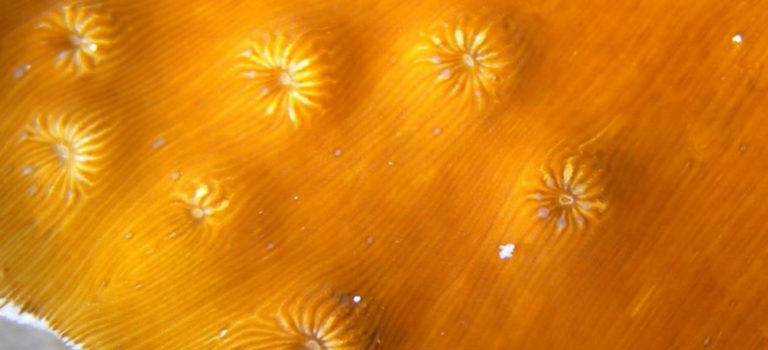
Surprising growth rates discovered in world’s deepest photosynthetic corals

【論文発表のお知らせ】世界最深の有藻性サンゴが驚異的な速度で成長することを発見
【プレスリリース】 地球温暖化が西インド洋の気候システムに与えた影響を解明 〜オマーン産サンゴから地球温暖化停滞時におけるインド洋ダイポール現象を復元〜
地球温暖化が⻄インド洋の気候システムに与えた影響を解明 〜オマーン産サンゴから地球温暖化停滞時におけるインド洋ダイポール現象を復元〜
渡邊 剛 理事長,山崎 敦子 所長らの研究成果が,英国時間2019年2月14日(木)公開のScientific Reports誌に掲載されました。
研究成果の詳細は下記URLにてご覧いただけます。http://kikaireefs.org/KIKAI-press_20190226.pdf
(山崎)
喜界島サンゴ礁科学研究所http://kikaireefs.org
